
The Republic of Texas, or simply Texas, was a breakaway state in North America that existed from March 2, 1836, to February 19, 1846. It shared borders with Mexico, the Republic of the Rio Grande, and the United States of America.

Santa Fe de Nuevo México was a province of the Spanish Empire and New Spain, and later a territory of independent Mexico. The first capital was San Juan de los Caballeros from 1598 until 1610, and from 1610 onward the capital was La Villa Real de la Santa Fe de San Francisco de Asís.

The United Mexican States is a federal republic composed of 32 federal entities: 31 states and Mexico City, an autonomous entity. According to the Constitution of 1917, the states of the federation are free and sovereign in all matters concerning their internal affairs. Each state has its own congress and constitution.

Benito Pablo Juárez García was a Mexican Liberal lawyer and statesman who served as the 26th president of Mexico from 1858 until his death in office in 1872. Of Zapotec ancestry, he was the first and only indigenous president of Mexico and the first democratically elected indigenous president in the postcolonial Americas. Previously, he had served as Governor of Oaxaca and had later ascended to a variety of federal posts including Secretary of the Interior, Secretary of Public Education, and President of the Supreme Court. During his presidency he led the Liberals to victory in the Reform War and in the Second French intervention in Mexico.

Agustín Cosme Damián de Iturbide y Arámburu(Spanish pronunciation:[aɣusˈtindeituɾˈbiðe] ; 27 September 1783 – 19 July 1824), commonly known as Agustín de Iturbide and later by his regnal name Agustín I, was the first Emperor of Mexico from 1822 until his abdication in 1823. An officer in the royal Spanish army, during the Mexican War of Independence he initially fought insurgent forces rebelling against the Spanish crown before changing sides in 1820 and leading a coalition of former royalists and long-time insurgents under his Plan of Iguala. The combined forces under Iturbide brought about Mexican independence in September 1821. After securing the secession of Mexico from Spain, Iturbide was proclaimed president of the Regency in 1821; a year later, he was proclaimed Emperor, reigning from 19 May 1822 to 19 March 1823, when he abdicated. In May 1823 he went into exile in Europe. When he returned to Mexico in July 1824, he was arrested and executed.

Guadalupe Victoria, born José Miguel Ramón Adaucto Fernández y Félix, was a Mexican general and politician who fought for independence against the Spanish Empire in the Mexican War of Independence and after the adoption of the Constitution of 1824, was elected as the first president of the United Mexican States. He was a deputy in the Mexican Chamber of Deputies for Durango and a member of the Supreme Executive Power following the downfall of the First Mexican Empire, which was followed by the 1824 Constitution and his presidency. He later served as Governor of Puebla.

Pedro Celestino Joseph Negrete y Falla was a Spanish politician and military man who served as a member of the interim government of México after the abolition of the First Mexican Empire. He fought alongside of Agustín de Iturbide in the royalist army during the Mexican War of Independence. He was a close collaborator of Iturbide during the empire and then pressured him to abdicate the Mexican crown.

Nicolás Bravo Rueda was a Mexican soldier and politician who served as interim President of Mexico three times, in 1839, 1842, and 1846. Previously, he fought in the Mexican War of Independence, and served as Mexico's first Vice President under President Guadalupe Victoria from 1824 until 1827, when he attempted to overthrow Victoria. He was also the fourth vice president under President Mariano Paredes in 1846, and served in the Mexican–American War.
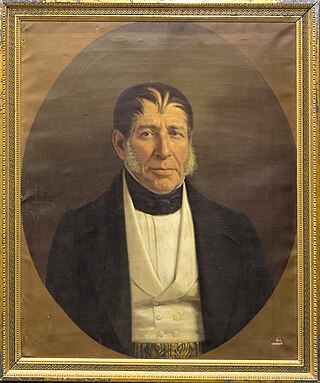
José Joaquín Antonio Florencio de Herrera y Ricardos was a Mexican statesman who served as president of Mexico three times, and as a general in the Mexican Army during the Mexican–American War of 1846–1848.

José Mariano Salas Barbosa was a Mexican soldier and politician who served twice as interim president of Mexico, once in 1846, during the Mexican American War, and once in 1859 during the War of Reform.

José Mariano Epifanio Paredes y Arrillaga was a Mexican conservative general who served as president of Mexico between December 1845 and July 1846. He assumed office through a coup against the liberal administration led by José Joaquín de Herrera. He was the grandfather of 38th Mexican President Pedro Lascuráin Paredes.
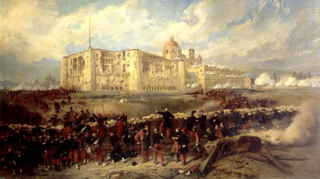
The second French intervention in Mexico, also known as the Second Franco-Mexican War (1861–1867), was a military invasion of the Republic of Mexico by the French Empire of Napoleon III, purportedly to force the collection of Mexican debts in conjunction with Great Britain and Spain. Mexican conservatives supported the invasion, since they had been defeated by the liberal government of Benito Juárez in a three-year civil war. Defeated on the battlefield, conservatives sought the aid of France to effect regime change and establish a monarchy in Mexico, a plan that meshed with Napoleon III's plans to re-establish the presence of the French Empire in the Americas. Although the French invasion displaced Juárez's Republican government from the Mexican capital and the monarchy of Archduke Maximilian was established, the Second Mexican Empire collapsed within a few years. Material aid from the United States, whose four-year civil war ended in 1865, invigorated the Republican fight against the regime of Maximilian, and the 1866 decision of Napoleon III to withdraw military support for Maximilian's regime accelerated the monarchy's collapse. Maximilian and two Mexican generals were executed by firing squad on 19 June 1867, ending this period of Mexican history.
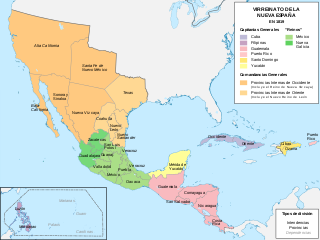
Nueva Vizcaya was the first province in the north of New Spain to be explored and settled by the Spanish. It consisted mostly of the area which is today the states of Chihuahua and Durango and the southwest of Coahuila in Mexico.
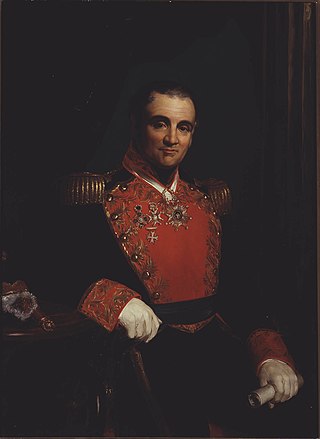
Trinidad Anastasio de Sales Ruiz Bustamante y Oseguera was a Mexican physician, general, and politician who served as the 4th President of Mexico three times from 1830 to 1832, 1837 to 1839, and 1839 to 1841. He also served as the 2nd Vice President of Mexico from 1829 to 1832 under Presidents Vicente Guerrero, José María Bocanegra, himself, and Melchor Múzquiz. He participated in the Mexican War of Independence initially as a royalist before siding with Agustín de Iturbide and supporting the Plan of Iguala.
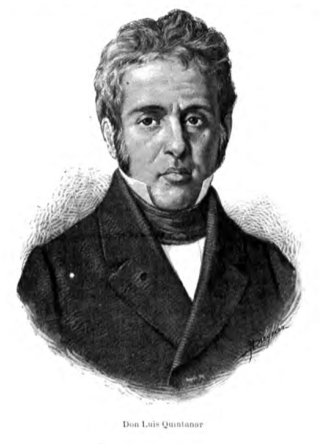
José Luis de Quintanar Soto y Ruiz was a Mexican soldier and statesman who briefly served as part of a triumverate which exercised the nation's executive power for a few days at the end of 1829 after the overthrow of President Vicente Guerrero.

The First Mexican Republic, known also as the First Federal Republic, existed from 1824 to 1835. It was a federated republic, established by the Constitution of 1824, the first constitution of independent Mexico, and officially designated the United Mexican States. It ended in 1835, when conservatives under Antonio López de Santa Anna transformed it into a unitary state, the Centralist Republic of Mexico.
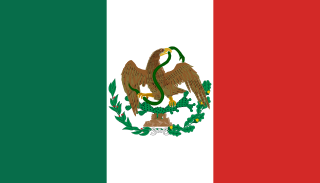
The Supreme Executive Power was the provisional government of Mexico that governed between the fall of the First Mexican Empire in April 1823 and the election of the first Mexican president, Guadalupe Victoria, in October 1824. After Emperor Iturbide abdicated, the sovereignty of the nation passed over to Congress, which appointed a triumvirate, made up of Guadalupe Victoria, Pedro Celestino Negrete, and Nicolas Bravo, to serve as the executive, while a new constitution was being written.
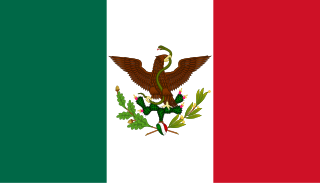
The Second Federal Republic of Mexico refers to the period of Mexican history involving a second attempt to establish a federal government in Mexico after the fall of the unitary Centralist Republic of Mexico in 1846 at the start of the Mexican-American War. It would last up until the Second French Intervention in Mexico led to the proclamation of the Second Mexican Empire in 1863.

The Centralist Republic of Mexico, or in the anglophone scholarship, the Central Republic, officially the Mexican Republic, was a unitary political regime established in Mexico on 23 October 1835, under a new constitution known as the Siete Leyes after conservatives repealed the federalist Constitution of 1824 and ended the First Mexican Republic. It would ultimately last until 1846, when the Constitution of 1824 was restored at the beginning of the Mexican-American War.
The Oaxaca Rebellion of 1823 was an armed conflict led by the Oaxaca government after the fall of the First Mexican Empire and the victory of the revolution of the Casamata Plan.



















